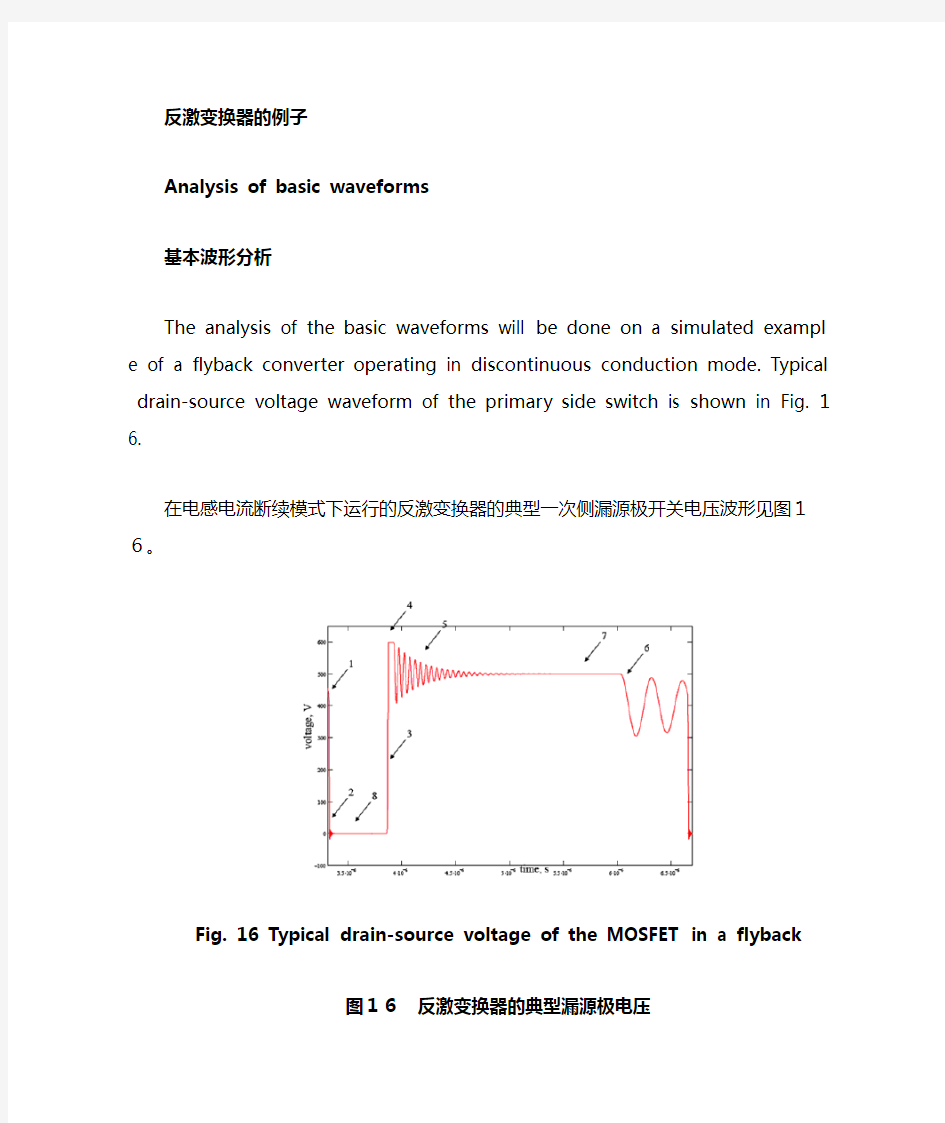反激的典型波形


反激变换器的例子
Analysis of basic waveforms
基本波形分析
The analysis of the basic waveforms will be done on a simula ted example of a flyback converter operating in discontinuous cond uction mode. Typical drain-source voltage waveform of the primary side switch is shown in Fig. 16.
在电感电流断续模式下运行的反激变换器的典型一次侧漏源极开关电压波形见图16。
Fig. 16 Typical drain-source voltage of the MOSFET in a flyback 图16反激变换器的典型漏源极电压
These drain-source voltage waveforms can be theoretically distin guished into typical elements. Different physical phenomena influen
ce the waveform at given time interval. Fig. 17 and Tab. 4 demo nstrate the main elements of the voltage waveform. The superposit ion of all these elements results in a typical drain-source voltage s hown in Fig. 16.
这些漏源极电压波形能用典型的理论来描述。各个时间段有不同物理现象影响这些波形。图17和平台4描述了电压波形的主要原理。把这些原理按时序整合呈现出图16所示的典型漏源极电压。
Fig. 17 Main elements of the drain-source voltage
图17漏源极电压的主要原理
原理1:开通期间的电压下降过程
原理2:在开通期间因寄生震荡产生的电流尖刺
原理3:关断期间的电压上升
原理4:缓冲电路的钳位电压
原理5:钳位过程结束后主要由场效应晶体管输出电容和变
压器漏感引起的寄生振荡
原理6:磁芯存储磁能释放完毕后主要由场效应晶体管输出电容和变压器电感引起的寄生振荡
原理7:反激变换器释放磁能期间的反射电压
原理8:与直流母线电压等幅的主要方波
Tab. 4 Main elements of the drain-source voltage
平台4漏源极电压的主要原理
The spectrum of the whole drain-source waveform (Fig. 16) is presented in Fig. 18.
图16所示的漏源极电压呈现的电磁干扰频谱见图18。
Fig. 18 Spectrum of the drain-source voltage (as shown in Fig. 1
6)
图18图16所示的漏源极电压呈现的电磁干扰频谱
The spectra of the main elements of the drain-source voltage c an be found in Fig. 20. Fig. 19 is exactly the same as Fig. 17 and has been repeated here for better under-standing.
图20描述了漏源极电压主要原理产生的电磁干扰频谱。为便于理解,将图17映射成图19。
Fig. 19 Main elements of the drain-source voltage (repeated, same
as Fig. 17)
图19漏源极电压的主要原理(正确重复图17)
Fig. 20 Spectra of the main elements of the drain-source voltage 图20漏源极电压主要原理产生的电磁干扰频谱
This method allows associating certain parts of the spectrum with their root causes, i.e. the peak at 20 MHz in the spectrum of the drain-source voltage is caused by the parasitic oscillation d ue to the output capacitance of the MOSFET and the leakage in ductance of the transformer.
这种方法可以确定电磁干扰频谱中某些频点的来源,也就是说漏源极电压产生的电磁干扰频谱中的20兆赫兹峰点是钳位过程结束后主要由场效应晶体管输出电容和变压器漏感引起的寄生振荡产生的。
The analysis of the drain current of the primary switch will b e done in the same way. Fig. 21 demonstrates a typical drain cur rent in a DCM flyback.
对一次侧开关的漏极电流进行分析采用相同的方法。图21展示出一个工作于电感电流断续模式反激变换器的典型漏极电流。
Fig. 21 Typical drain current in a flyback
图21反激变换器的典型漏极电流
This waveform can be presented as a superposition of the follo wing elements (Fig. 22 and Tab. 5). The superposition of all these elements results in a typical drain current shown in Fig. 21.
这个波形可以被看作是下列原理的叠加(图22和平台5)。全部这些波形的叠加整合结果变成图21所示的典型漏极电流。
图22漏极电流的主要原理
原理1:漏极电流的主要三角波形
原理2:在开关开通期间因寄生分布电容引起的电流尖刺
原理3:钳位过程结束后主要由场效应晶体管输出电容和变
压器漏感引起的寄生振荡
原理4:磁芯存储磁能释放完毕后主要由场效应晶体管输出电容和变压器电感引起的寄生振荡
Tab. 5 Main elements of the drain current
平台5漏极电流的主要原理
The spectrum of the whole drain current waveform (Fig. 21) is presented in Fig. 23.
全部漏极电流波形产生的电磁干扰频谱(图21)呈现在图23。
Fig. 23 Spectrum of the drain current (as shown in Fig. 22) 图23漏极电流产生的电磁干扰频谱(与图22相同)
The spectra of the main elements of the drain current can be found in Fig. 25. Fig. 24 is exactly the same as Fig. 22 and ha s been repeated for better understanding.
漏极电流主要原理产生的电磁干扰频谱见图25。图24和图22相同。
Fig. 24 Main elements of the drain current
图24漏极电流的主要原理
Fig. 25 Spectra of the main elements of the drain current
图25漏极电流主要原理产生的电磁干扰频谱
As in case of drain-source voltage this method allows to associ ate the elements of the drain current waveform with its contributi on to the whole spectrum. For example, the peak at 20 MHz in
the spectrum is caused by the parasitic oscillation due to the out put capacitance of the MOSFET and the leakage inductance of t he transformer.
就象漏源极电压的例子那样,用这种方法也可以找出漏极电流的哪一部分对电磁干扰频谱产生影响。举例说明,20兆赫兹的峰点是钳位过程结束后主要由场效应晶体管输出电容和变压器漏感引起的寄生振荡产生的。
This method of separating the waveform in time domain into i ts main elements helps to find out what part of the spectrum in frequency domain caused by what related physical phenomena. Th e separation into main elements should be done in respect of reaso nable events in the power circuit like on and off slopes, oscillatio ns, clamping, snubbering, reflected voltage, etc.
这种在时域里对主要原理进行拆分的方法有助于找出产生电磁干扰频段的干扰源。这种离析主要原理的手法有助于合理审视电源电路里诸如变化速率、振荡、钳位、缓冲、反射电压等过程。
In this flyback example only the primary switch has been anal yzed as active source of electrical noise. There are also others, like secondary side diodes or synchronous rectifier, control IC (especiall y its gate drive), etc. In order to obtain more complete analysis al l these interference sources have to be analyzed.
在这个反激变换器里只对一次侧开关进行电磁噪声产生的分析。但是还有其他的部分,象二次侧的二极管或同步整流器、控制集成电路(尤其是它们的栅极驱动)等等。按顺序分析将获得更完善的关于这些电磁干扰源的解析。
However, it is impossible to predict the conducted EMI spectr um using this approach due to the fact, that only interference sou rces are considered. There is no analysis of the spreading paths of the interference in this method.
然而,这种方法不可能预知用频谱反映的电磁干扰的实际行为,仅仅是干扰源被重视起来。在那里没有对分布参数产生的干扰进行分析的方法。
Nevertheless, the association of harmonics root cause with the respected physical phenomena will reduce the efforts of EMI reduc tion. The impact of the identified root cause can be reduced not only by filtering, but also by means of influencing the root cause itself.
不过,重视物理现象并不能成就电磁干扰的降低。降低干扰并不仅仅是滤波,也同样意味着干扰源自身的影响。
Operation modes of discontinuous flyback converter
电感电流断续工作反激式变换器的运行模式
